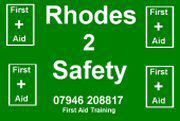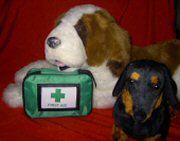| |
Know what to do before you need to do it...
 Agility is
a fast-moving, high-energy, dynamic sport which, when executed correctly, is smooth, seamless
and exhilarating to watch. Sadly, things don’t always go according to plan and the odd
accident or mishap does sometimes happen, usually as a result of our poor handling –
‘cos it's always the handler and never the dog, isn't it? The usual scenarios
that present themselves when owning a dog, coupled with the added dangers Agility can
bring, are often the catalyst for people looking for first aid training. Kerry Rhodes
of Rhodes 2 Safety, provides canine first aid courses direct to agility clubs. Agility is
a fast-moving, high-energy, dynamic sport which, when executed correctly, is smooth, seamless
and exhilarating to watch. Sadly, things don’t always go according to plan and the odd
accident or mishap does sometimes happen, usually as a result of our poor handling –
‘cos it's always the handler and never the dog, isn't it? The usual scenarios
that present themselves when owning a dog, coupled with the added dangers Agility can
bring, are often the catalyst for people looking for first aid training. Kerry Rhodes
of Rhodes 2 Safety, provides canine first aid courses direct to agility clubs.
I was delighted
to be approached by East Yorkshire AC to provide a Canine First Aid seminar for their
members. We organised an evening session in February with 15 members of the club - a smashing
group of like-minded, barmy dog-folk, not short on either common sense or a sense of humour
come to that! I have actually been a member of EYAC myself since August but what I do for a
living only came up in conversation in late January and as soon as word got out, the members
quickly rallied the troops and a course was organised.
We
got together in a room kindly provided by Genesis Dental Care in Hull, had a quick chat and a
coffee to welcome everyone and settle them in, and then we were off. The seminar, which takes
three hours to complete, looks at all the major techniques a dog-owner may need from artificial
respiration and CPR right through to treatment of bleeding and fractures. We also cover the
more 'ordinary' day-to-day problems that often come up when you own a dog, such as a
caught or bleeding nail, burns, stings, choking and even road traffic accidents. Although
being able to perform mouth-to-muzzle is what many people often
consider first aid is all about, it is in fact being able to recognise and treat conditions
such as shock and blood loss that will set you aside from those who are found wanting should
the unthinkable happen.
Emergency only
Its important to stress that the skills taught in a Canine First Aid course are only
intended for use in emergency situations. They are designed to buy time to get an injured
animal time to a vet. They are in no way intended to replace the services of veterinary
professionals and in fact, by law, one should only be performing first aid procedures on our
own animals. It is very important to remember that only a qualified vet has the legal
authorisation to carry out medical intervention on an animal other than their own.
That said, this seminar is devised specifically for people just like you - ordinary members of
the pubic - whether you have a special interest in Agility, Flyball, breed showing or just that
you want the best for your companion. The course leads you through the skills you need to give
you confidence and clear understanding, and links each section in a methodical,
straight-forward manner. We don't use any jargon or flash terminology, just solid explanations
and examples with the odd basic drawing on a flip chart to emphasize a point or make it a
little clearer although it must be appreciated that I'm no Picasso!
 Hands-on-learning Hands-on-learning
As
always, I demonstrated on Snogbitz, my resuscitation St. Bernard who is always pleased to
participate in a bit of human-to-doggy snogging. Admittedly, Snogbitz is much bigger
than the majority of dogs I know, but his size does make it much easier to point out basic
anatomical features such as where to find a pulse, how to extend the airway and where abouts to
place our hands during CPR. But don't panic if your dog is just a little guy, I also have my
demonstration dachshund (Dachshund Cherry) so you can see exactly how the techniques are
applied to the smaller breeds, too. To be able to see the techniques
performed right in front of you really does bring things to life and hopefully will anchor the
information firmly in the mind's eye.
After
discussing the finer points of blood loss and the techniques we could use to prevent it,
everybody had a go at applying a pressure bandage, something that always results in much
hilarity as the students locate their inner 'doctors and nurses.' Divided up into pairs, each
member of the group became either the first aider or the canine patient, to practice their
skills. My students are usually surprised when I ask them to do this on each other rather than
on an animal but, doing this means not only do you get to try out your new found abilities, but
you also get verbal feedback from your human 'dog' to let you know exactly what they think of
your talents – and it's not always as complimentary as you'd like! It's amazing how tricky it
can be to get the dressings just right. Too tight will cut off the circulation to the limb and
too slack will just not stop the bleeding at all. After a couple of goes, everybody finally
mastered it and I'm sure will feel much more confident about applying a pressure bandage in
future, safe in the knowledge that their mistakes were made on their human dummy rather than on Fido himself.
After the three hours of chatting, discussing, practicing - and a considerable amount of down
right giggling -the session finally drew to a close as I recapped the main points we'd covered
and ensured that everyone felt calm and confident with their new found knowledge. I gave out
printed handouts for the students to take away, which highlighted the main topics as an aid de
memoir. Then had the pleasure of presenting their very snazzy certificates, each one
listing the subjects we'd tackled and personalised with the candidates name and a super red
seal featuring an embossed Rhodes 2 Safety logo. While selling merchandise is definitely not my
main priority when delivering our Canine First Aid Seminars, I do often get asked where a good
first aid kit can be purchased and exactly what should be included in it. For this reason,
Canine first aid kits are now always on sale at the end of our seminars. for people to buy
should they wish. On this occasion, they all went!
We run open
courses occasionally for individual people to slot on to but also put seminars on specifically
to meet the requirements of independent clubs and organisations. As word of our reputation
spreads, we've found ourselves very busy of late, travelling up and down the length and bredth
of the country from as far afield as Wakefield and Birmingham, right up to Linlithgow in
Scotland so, as you can see, we really do get about a bit!
If
you’d like to see what past students had to say about Rhodes 2 Safety, feel free to check out
our website at
www.rhodes-2-safety.co.uk or just get in touch to book a course for your Club. We’d love to
meet you and make your Agility experience as safe as possible for you and
your dog.
 About
the author... About
the author...
Kerry Rhodes,
owner of Rhodes 2 Safety First Aid Training, has always been partial towards anything medical
but her first love is - and always has been - her dogs.
She
has two beautiful Rhodesian Ridgebacks, Axl and Rain whom she shows under the breeders affix of
Metalrock. At the tender age of six, she fell in love with Ridgebacks but it took her until
2006 to finally get her dream dog, Axl.
Kerry
recently stumbled into the fascinating world of Agility and wow,
what a dynamic and exciting world that has turned out to be - a world even more likely to need
good first aid training than the show ring. Having taught human first aid for many years and
more recently studied Advanced Canine First Aid in Ascot, Berkshire, she feels so lucky that to
have been able to incorporate the two things she is most passionate about in life, and actually
make a living at it! Canine First Aid Training was a very natural progression for her, and she
delights in being able to pass on the skills it brings to anyone with a doggy mind. When you're
a "dog person", there's not much you wont do keep them safe and as Kerry herself says, First
Aid is something that really can make a difference.
First published 6 March 2012
| |
|